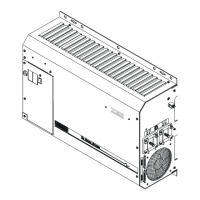INSTALLATION
Page
20
Copyright Trace Engineering Company, Inc.
5916 - 195th Street N.E.
Arlington, WA 98223
Telephone: 360/435-8826
Fax: 360/435-2229
www.traceengineering.com
PS Series Inverter/Charger
Part No. 3597
Rev. D: November 23, 1999
AC INSTALLATION GUIDELINES
The following steps are a basic guideline for connection of the AC wiring into and out of the inverter.
1. Disconnect the inverter from the battery bank (if already connected), by either removing the DC side
fuse, or opening the DC disconnect. Then remove the AC wiring compartment cover from the front of
the inverter by removing the two screws on the cover.
2. If conduit will be utilized (consult code, it may be required in your installation), determine which
knockout(s) will be utilized and remove them from the inverter. The knockout sizes are shown in
Figure 38, PS Series – Showing Knockout Sizes for AC Wiring on page119. Using appropriate
conduit connectors, fasten the conduit to the inverter. Feed all AC wiring through the conduit and into
the inverter AC terminal block. Be sure to leave yourself several extra inches of wire to work with.
Remember that you need at least two sets of three conductor wiring, one for AC Hot, neutral, and
ground into the inverter, and another for AC hot, neutral and ground out of the inverter to the loads.
Torque all AC terminals to 10 to 15 inch-pounds.
3. Connect the hot (black) and neutral (white) wires from the AC source to the AC HOT IN and AC
NEUTRAL IN terminals in the AC terminal block. The safety ground (green) should be connected to
the terminal stud labeled “AC Ground” bolted to the chassis. Repeat the procedure for the AC wiring
going to the AC sub-panel which will power the loads, except connect these wires to terminals labeled
the AC HOT OUT and AC NEUTRAL OUT.
4. Inspect all wiring for proper installation and then replace and secure the access cover.
IMPORTANT PRECAUTION
The AC output of the inverter must at no time be connected directly to utility power or a generator.
This condition can be far worse than a short circuit. If the inverter survives this condition, it will shut down
until corrections are made. Connection to a utility or generator must be only done internally by the
inverters built-in relays. This allows the inverter to first synchronize to the other AC sources waveform,
preventing damage. Connect the utility or generator only to the provided AC HOT IN and AC NEUTRAL
IN terminals. When the inverter output is connected directly to an external source, the inverter will shut
down and indicate an error. With the SWRC connected, the ERROR CAUSES menu heading will show a
YES for the AC SOURCE WIRED TO OUTPUT menu item. Either determine the source of the AC or call
a qualified electrician to correct the situation.
EXTERNAL AC TRANSFER RELAYS
It is not acceptable to switch the AC input from one AC source to another while the inverter is
connected. While the inverter is connected, switching the AC input from one source to another can result
in a loss of synchronization that can cause a severe overcurrent condition that is far worse than short
circuiting the inverter. If a transfer relay is used, it must provide a center “OFF” (“break before make”)
position that causes a loss of input power to the inverter for a period of at least 100 milliseconds.
This will allow the inverter to disconnect from the original AC input and then re-synchronize to the new AC
source though the AC input terminal. During the transition period, the inverter will have to operate the
load while it re-synchronizes to the new AC source (about a thirty-second period at the minimum). Most
transfer relays will switch too fast for the inverter to detect - and will cause the inverter to lose
synchronization with the AC source. This is indicated by the inverter shutting down upon transfer and the
red ERROR LED indicator turning on.
Manually, hand operated transfer switches may be acceptable since the transfer time can be slow enough
for the inverter to detect. The switch must go through a center “OFF” position. They are often used to
switch from one generator to another.
120 VAC GROUND FAULT INTERRUPT OUTLETS (GFI’S)
The following 120 VAC GFI's have been tested and found to work satisfactorily with our inverters:
LEVITON 6599
PASS & SEYMOR 1591 4A957
ACE Hardware ACE 33238

